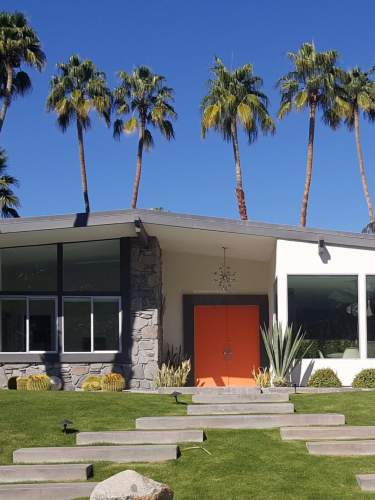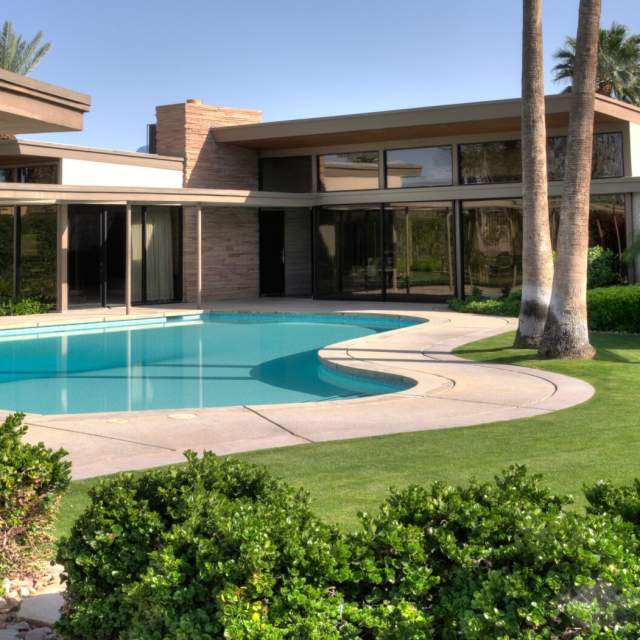Midcentury Architecture Self-Guided Tour
Palm Springs has one of the world’s largest concentrations of preserved mid-century modern architecture. Talented young visionary architects came to Palm Springs and interpreted Modern architecture in a way that best suited the desert environment and leisure living. Their design talents are celebrated every year during Modernism Week. Let’s explore the architecture through the neighborhoods.
Before we begin, a little background.
What is Desert Modernism?
Desert Modernism is an interpretation of the Modernist or International Style, tailored to suit the Palm Springs indoor/outdoor lifestyle. People flocked to Palm Springs for the stunning fall/winter weather and wanted to spend their time outdoors. Desert Modernism is recognizable by its minimalist, clean lines and the seamless blur of indoor and outdoor space. Rooflines are often flat or butterfly-wing v-shaped (dubbed “butterfly” roofs). Floor plans were open, and there were many windows and sliding glass doors that brought the outside in. Beautiful breeze blocks temper the desert heat, and attached carports rather than detached garages fulfill the need to shelter the automobile.
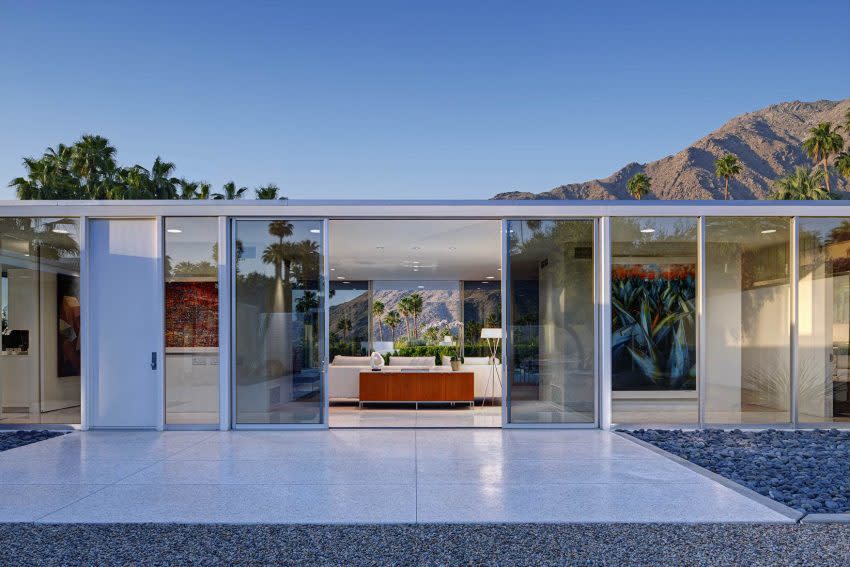
William Cody, Architect
Notable Architects from the Mid-Twentieth Century Who Practiced in Palm Springs
Richard Neutra (1892 – 1970) – Austrian-born, raised, and trained, Neutra immigrated to the U.S. in 1923, where he worked with Frank Lloyd Wright before branching out on his own. Neutra designed homes in Palm Springs, including the Miller Residence (1937) and his masterpiece, The Kaufmann Residence (1946).
John Lautner (1911 – 1994) – After training under Frank Lloyd Wright at Taliesin West, Lautner moved to LA and focused on residential architecture. His distinctive application of the principles of organic architecture culminated in the Palm Springs homes for Arthur Elrod and Bob Hope. These homes are in a gated Southridge community and are not accessible to the public, although the Hope residence can be seen on the side of the mountain from East Palm Canyon Drive.
Donald Wexler (1926 – 2015) – Donald Wexler worked for Richard Neutra for a while in LA, then relocated to Palm Springs, where he was employed by William Cody. Wexler partnered with Richard Harrison for a time. Together, they designed many school buildings and the Steel Development Homes for Alexander Construction Company. Other notable designs include the Dinah Shore Residence, the main terminal building at the Palm Springs International Airport, and Royal Hawaiian Estates Condominiums.
William “Bill” Krisel (1924 – 2017)—Krisel studied architecture at the University of Southern California and also became a licensed landscape architect. It is estimated that 30,000 residences in Southern California can be attributed to Krisel. As a personal friend of Bob Alexander, he is credited as the architect of record for many Alexander Construction Company developments.
E. Stewart Williams (1909 – 2005) – Williams studied at Cornell and the University of Pennsylvania. Some of his notable Palm Springs designs include the Palm Springs Art Museum, Coachella Savings and Loan (now Chase Bank), Santa Fe Federal Savings & Loan (now the Art Museum’s architecture and design center), Palm Springs Aerial Tramway station, and Frank Sinatra residence.
William Cody (1916 – 1978): Cody studied architecture at the University of Southern California before moving to Palm Springs in 1946. The following year, he designed the Del Marcos Hotel and went on to work on several clubhouses and Country Club developments throughout the Coachella Valley. Cody’s celebrated designs include the Abernathy House, Palm Springs Public Library at Sunrise Park, St. Theresa’s Catholic Church, and the L’Horizon Hotel.
Albert Frey (1903 – 1998) – Frey established a style of modernist architecture in Palm Springs known as “Desert Modernism.” He worked in Paris for Charles-Edouard Jeanneret (commonly known as Le Corbusier) before moving to the U.S. in 1928. He then worked with New York architect A. Lawrence Kocher in New York City for some years as the managing editor of Architectural Record magazine. A small commission for an office and apartment for Kocher’s brother, Dr. J.J. Kocker, brought Frey to Palm Springs. In California, he worked with architect John Porter Clark. Buildings of note include Frey House I and II and the Tramway Gas Station (now the Palm Springs Visitor Center), the Raymond Loewy Residence, and the Palm Springs City Hall.
John Porter Clark (1905 – 1991) – Clark studied architecture at Cornell and apprenticed with Garrett Van Pelt in Pasadena. He relocated to Palm Springs to find more work and is credited as one of the pioneers of “Desert Modernism.” In 1935, Clark met Albert Frey and collaborated on many projects, including the Palm Springs City Hall, the Welwood Murray Memorial Library, the Palm Springs Woman’s Club, and St Paul’s in the Desert church.
George and Robert Alexander (developers) – The Alexander Construction Company was founded by George Alexander and his father, George. They specialized in affordable tract residential developments in Southern California post World War II. The prolific developers helped make second home ownership in Palm Springs affordable to the growing middle class. Their homes are known as the “Alexanders,” though most of the development’s architecture is credited to William Krisel and Dan Palmer. They also partnered with architects Charles Dubois and Donald Wexler. Alexander developments in Palm Springs include Twin Palms, Vista Las Palmas, Racquet Club Road Estates, Desert Lanai, and Sunmore Estates, among others.
Hugh Kaptur (1931 – ) – Kaptur studied architectural engineering at the Lawrence Institute of Technology in Detroit, Michigan. He relocated to Palm Springs in 1956 and apprenticed for Wexler and Harrison. Kaptur is recognized for his design of the Steve McQueen Residence, the William Holden Residence (both gated and private), several home designs for the Ranch Construction Company (now Desert Park Estates Neighborhood), the clubhouse at the Mesquite Golf Course, Tahquitz Plaza office buildings, the Triangle Inn, Fire Station #3 (with Robert Ricciardi) and Fire Station #4, the Musicland Hotel (renovation) among others.
Jack Meiselman (developer)—Jack (1899 – 1994) Meiselman developed many single-family homes in and around Palm Springs in the 1950s and 60s. Their homes, designed by a young architectural designer named John “Jack” Moyer, featured many of the same design features and construction methods seen in the post-and-beam homes by the Alexander Development Company. The Meiselmans built approximately 350 homes in Palm Springs.
A. Quincy Jones (1913 – 1979)—Jones worked with a slew of modernist architects, including Douglas Honnold, George Vernon Russell, Burton A. Schutt, and Paul Williams. He later partnered with Paul Williams on several Palm Springs projects, including the Palm Springs Tennis Club (1947), the Town & Country Restaurant (1948), and Country Club Estates Condominiums.
Palm Springs Self-Guided Architecture Tour
This self-guided tour is a mere introduction to the amazing collection of extraordinary buildings in Palm Springs designed during the mid-twentieth century. Many of the architects of these buildings were not well-known. They were young architects, often at the beginning of their careers, who were exposed to many prolific and noteworthy modernist architects. They found eager clients in Palm Springs ready to throw off the tired revivalist and traditional styles and embrace fresh new ideas of the Modern Movement.
Begin at the Palm Springs Visitor Center – 2901 N. Palm Canyon Drive
Albert Frey designed the Tramway Gas Station, now the Palm Springs Visitor Center.
This remarkable Modernist structure was constructed between 1963 and 1965 as a gas station. The roof is constructed of corrugated galvanized steel, spanning over 95 feet, and supported by six steel pipe columns. The dramatic structure was created to draw the attention of motorists entering Palm Springs. In the 1990s, the building was threatened with demolition by the property owners. Fortunately, cooler heads prevailed, and the building was granted Class 1 historic landmark status shortly after it became the Palm Springs Visitor Center.
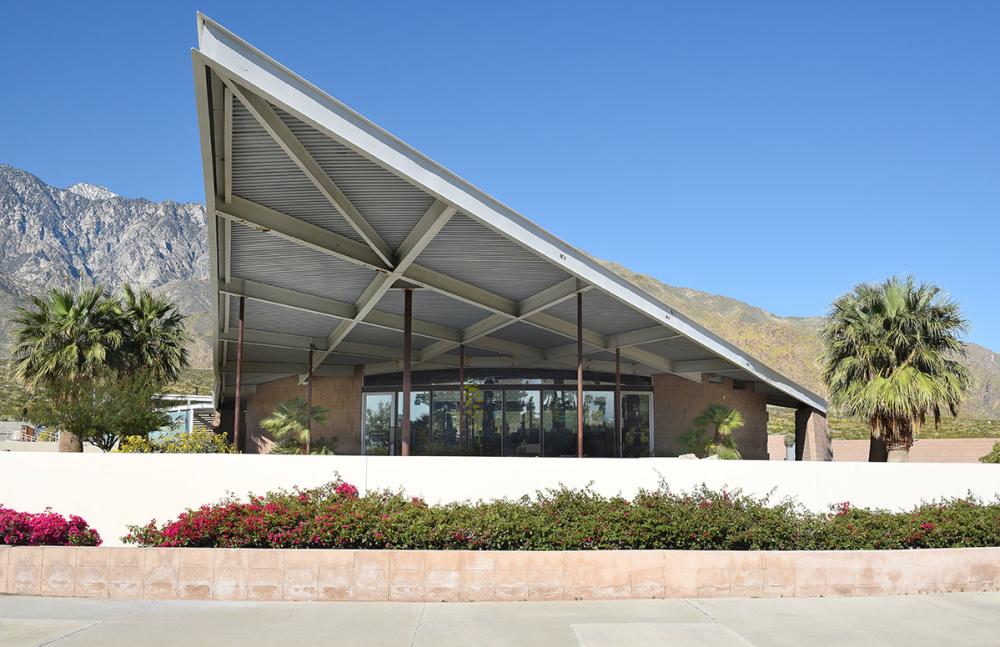
There are several architecture books available at the Visitor Center, as well as various gifts and information. For those who want to see even more Palm Springs midcentury architecture than this tour provides, buy a map produced by the Palm Springs Modern Committee.
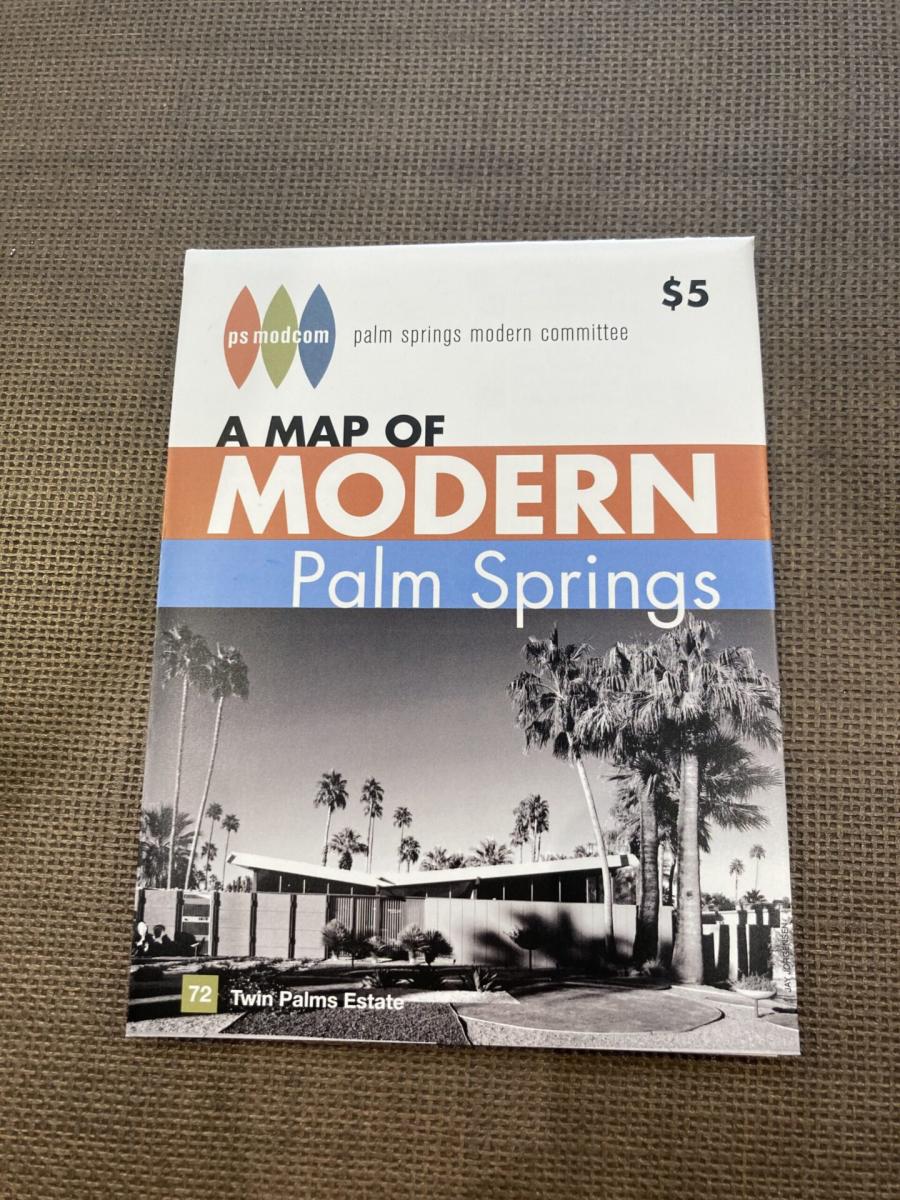
There is also a printed Hollywood Star Home self-guided tour map for purchase, which shows where many of the Hollywood stars lived, which helped make Palm Springs world famous.
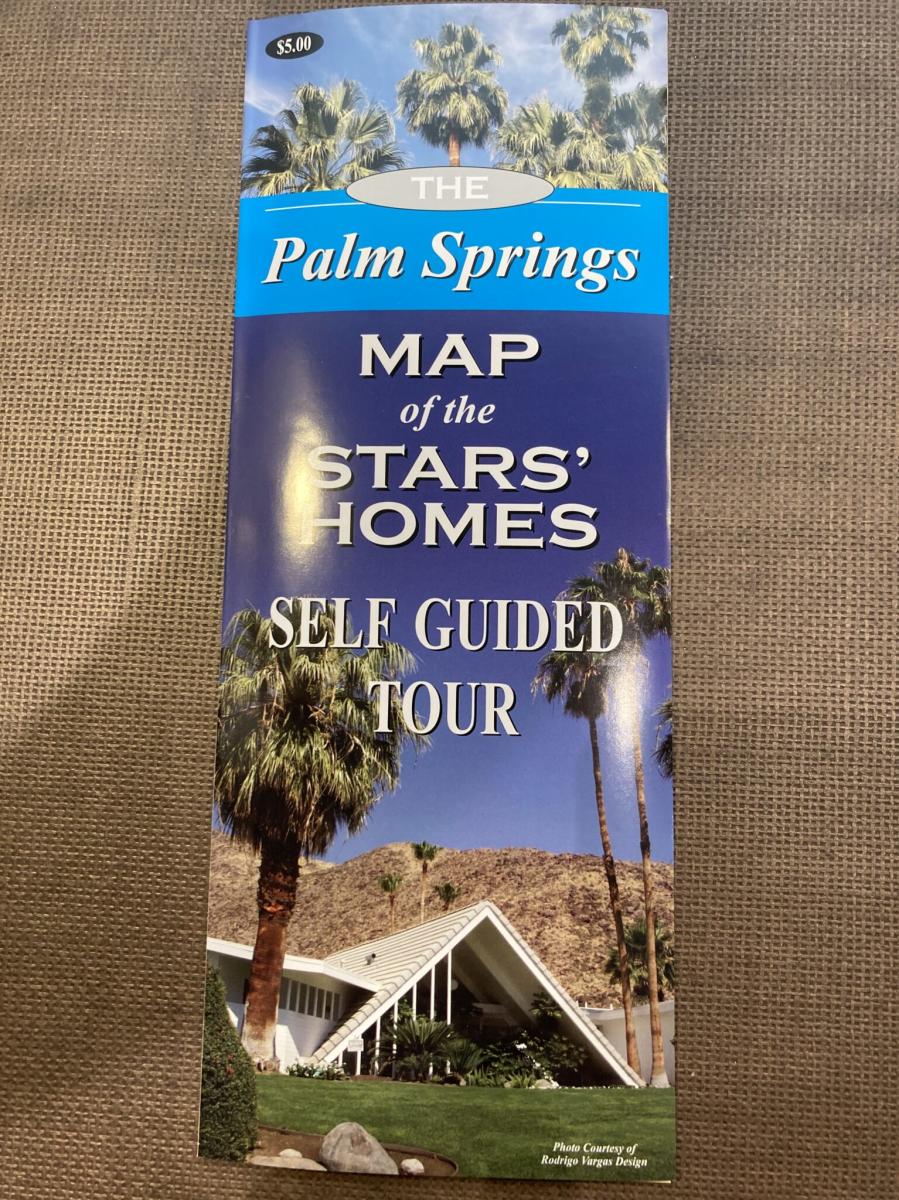
Tramway Shell Station – (William Cody, architect, constructed 1964)
2796 North Palm Canyon Drive
On the east side of Palm Canyon, just south of San Rafael, is another dramatic automobile service station designed by architect William Cody. The station is comprised of an ultra-thin cast-in-place concrete roof. The service bays and attendants’ offices are a simple cubic volume that appears to have been carefully slid under the thin roof plane. Lighting in the canopy was deftly integrated into the roof plane in recessed troffers that had most recently been retrofitted with LED lighting. The buildings’ minimalist design and thin roof profile are a trademark of Cody’s work in the desert.
Head down San Rafael Drive across the street from the Visitor Center. Turn right on Indian Canyon Drive and left on East Simms Road.
Racquet Club Estates
A short distance from the Palm Springs Visitor Center off Indian Canyon Drive is Racquet Club Road Estates, developed by the Alexander Construction Company. Racquet Club Estates boasts the Steel Development homes by Donald Wexler on Sunnyview, Simms, and Molina Roads, dozens of “Alexanders” designed by Palmer & Krisel, and a collection of mid-century homes developed by Jack Meiselman, designed by Jack Moyer.
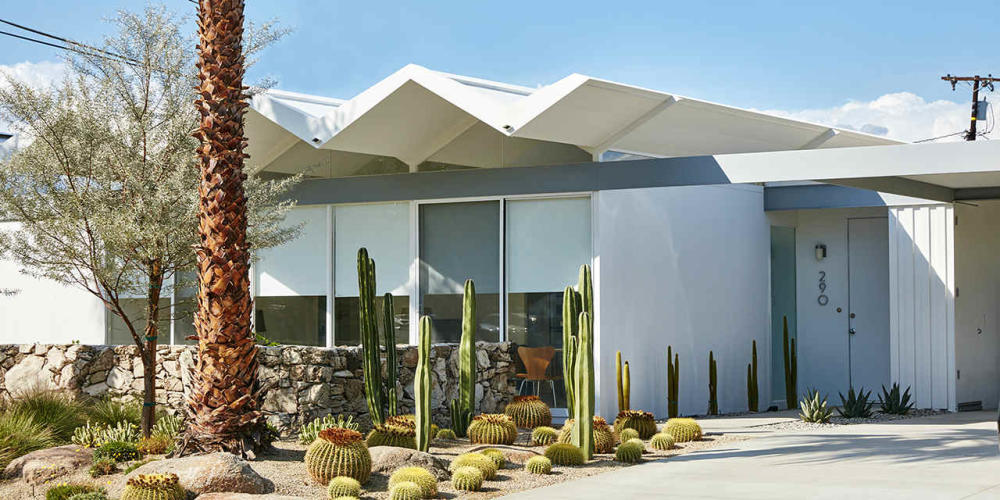
Alexander Construction Company Steel Houses
290 Simms Road
300 and 330 East Molino Road
3100, 3125, 3133 and 3165 North Sunnyview Drive
Designed in 1960 by Donald Wexler and Richard Harrison, these pre-fabricated, all-steel homes were to fill an entire neighborhood. However, after seven homes were built, rising steel prices made further homes in this style cost-prohibitive. All seven homes are now Class One historic sites and listed on the National Register of Historic Places.
Head South on Sunnyview toward Francis Drive
Palmer & Krisel designed homes
325 East Francis Drive
388 and 520 Desert Holly Circle
970 East Racquet Club Road
455 and 483 East Francis Drive (flamingo letterbox)
A close personal friend of developer Bob Alexander and his family, Krisel came to the Desert at the request of Alexander to design a tract of modernist houses dubbed Smoke Tree Valley (now known as Twin Palms for the pair of palm trees that were included with the completion of each of the homes).
Other Palmer & Krisel projects include the Ocotillo Lodge, Las Palmas Estates (Vista Las Palmas), Kings Point, Canyon View Estates, and Racquet Club Estates. The “House of Tomorrow,” conceived as an experiment in modern living, impressed Alexander’s wife Helene so that they made it their residence. The house later gained fame as the honeymoon home of Elvis and Priscilla Presley. (1350 Ladera Circle)
Head back to Indian Canyon Drive and make a left. Drive approximately one mile.
Chino Canyon/ Little Tuscany Estates
Grace Lewis Miller Residence (Richard Neutra – 1937) – 2311 N. Indian Canyon Drive
Although a tiny home, it combined a dance studio for the owner. It is a good representation of Neutra’s use of simple, flat-roofed forms arranged and adapted to the sun, outdoor space, and the need for coolness and ventilation in the desert. He specialized in extending architectural space into a carefully arranged landscape.
Head South on Indian Canyon and make a right on West Vista Chino.
Kaptur Court – 262-266 West Vista Chino
Kaptur came out of retirement in 2016 and designed three iconic mid-century-style single-family homes, reflecting his own interpretation of mid-century modernism.
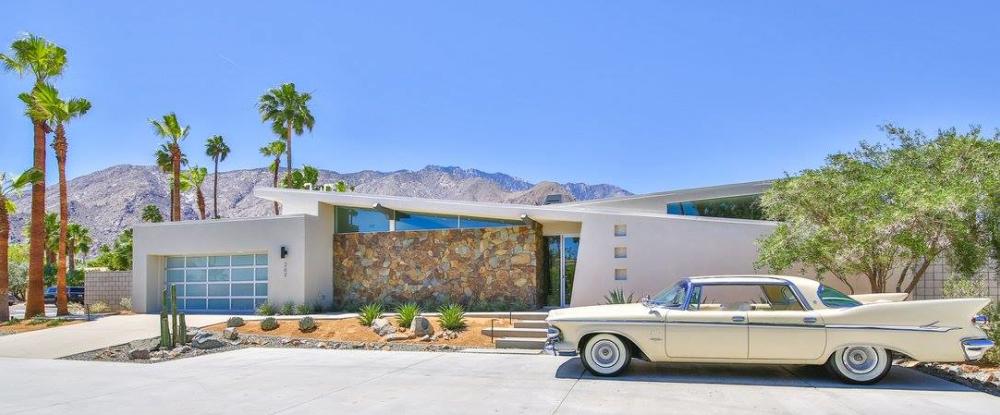
Turn right on N Via Norte and left on W Chino Canyon Road, then head up the hill. If you stay left, you will pass the home owned by Elvis Presley at 825 W Chino Canyon.
Edris Residence ( E. Stewart Williams – 1954) – 1030 W Cielo Drive
William and Marjorie Edris had seasonally rented an apartment in one of the Potter Clinic Building’s upstairs apartments at the same time as the Williams family in the late 1940s. The two couples became friends, and in 1953, William Edris hired E. Stewart Williams to design a winter residence. The parcel chosen was located in the rocky area dubbed “Little Tuscany,” located on the lower portion of the Chino Cone alluvial fan. Taking full advantage of the unique location, Williams moved only those boulders necessary to place the house on a flat surface with the goal of integrating as much of the natural environment into the design as possible. Native rock was used for the prominent chimney, which anchored the southeastern portion of the home alongside the floor-to-ceiling wall of glass on the east wall of the living room, which afforded breathtaking views of the Coachella Valley. Almost the entire pool is surrounded by boulders.
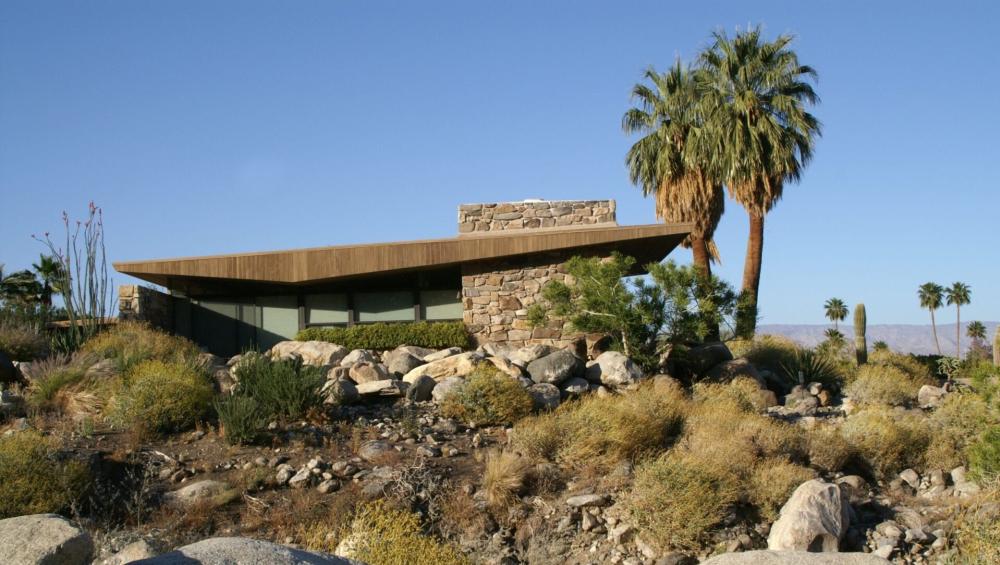
Dr. Franz Alexander Residence (1956) – 1011 West Cielo Drive
Historic, original, and spectacular, this home is a midcentury modern dream. Designed by architect Walter S. White for psychoanalyst Dr. Franz Alexander, the Alexander Residence, appears to hover over the boulders-strewn site. The result is a structure that seamlessly integrates into its natural surroundings, enhancing views of the valley while creating numerous indoor-outdoor connections.
. Dramatic architectural elements like V-shaped steel supports, a swooping tongue-and-groove ceiling reaching toward the mountains, plus a double-height atrium—with an open-tread black steel staircase designed by Albert Frey—are but a few of the incredible details that bring the residence to life.
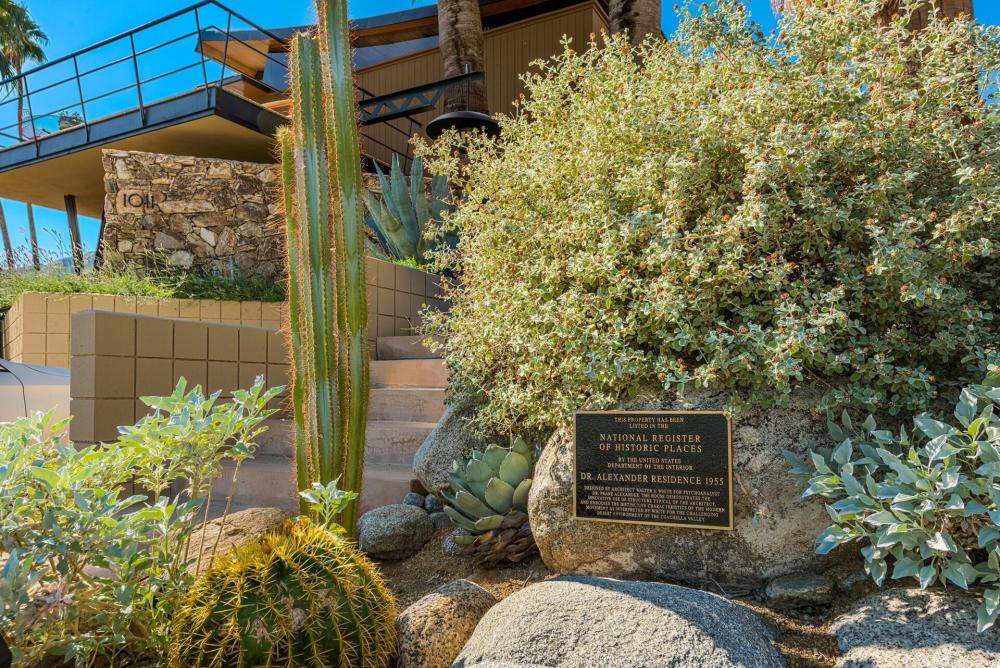
Head back down to Vista Chino and make a right.
Kaufmann Residence (Richard Neutra – 1946) – 470 West Vista Chino Road
Edgar Kaufmann hired Neutra to design a desert home for his family. Frank Lloyd Wright had built Fallingwater for Mr. Kaufmann a decade earlier in Bear Run, Pennsylvania. Having seen Taliesin West, Kaufmann thought that Wright didn’t understand desert design and chose Neutra instead. The home turned out so well that when Wright saw it, he admitted that it was beautiful (uncharacteristic of him). The building remains the most famous in Palm Springs in terms of international recognition.
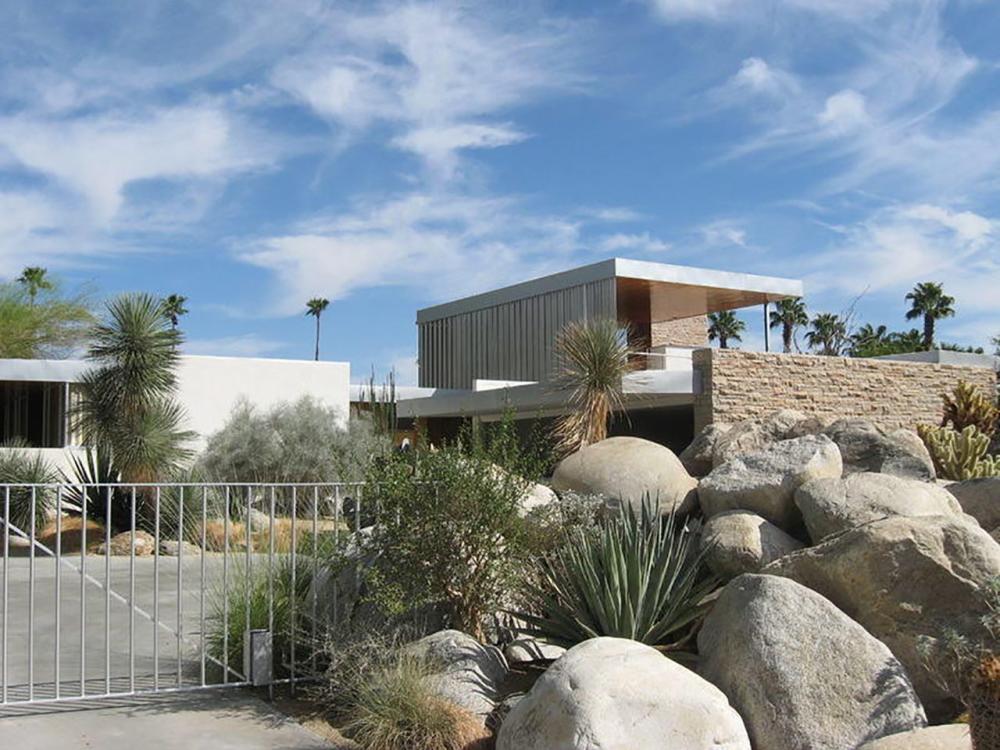
Go to the end of the road and turn left on North Via Monte Vista
Vista Las Palmas and Old Las Palmas
Swiss Misses (Charles DuBois – 1903 – 1) – 755 W Crescent Dr.
Du Bois attended architecture school at UCLA for a year and then transferred to MIT. Traveling between coasts and working at different architectural firms, Du Bois passed the California architectural licensing exams in the 1930s and started his firm in 1938. When housing construction slowed during WWII, he worked as a senior set designer for MGM Studios.
He is known for the few Swiss Miss Houses in Palm Springs featuring the A-frame entry.
Examples include:
1133 Vista Vepero – 1958
1110 Abrigo Road – 1958
775 W Crescent Drive – 1958
700, 855 Via Las Palmas – 1959
1355 N Rose Ave – 1961
These homes were built in the Vista Las Palmas neighborhood, developed by Joe Dunas and the Alexander Construction Company. There are 15 Swiss Miss Houses remaining today in Vista Las Palmas.
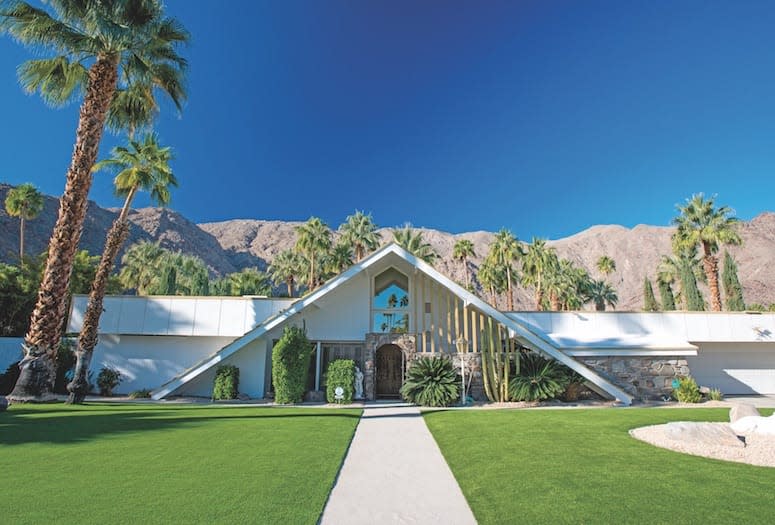
Dinah Shore Residence – 432 Hermosa Place
Leonardo DiCaprio acquired Dinah Shore’s Palm Springs Home for $5.2 Million in 2014. Designed by architect Donald Wexler for Dinah Shore in 1964, this legendary Palm Springs’ Old Las Palmas neighborhood tennis estate defines timeless mid-century modern architecture.
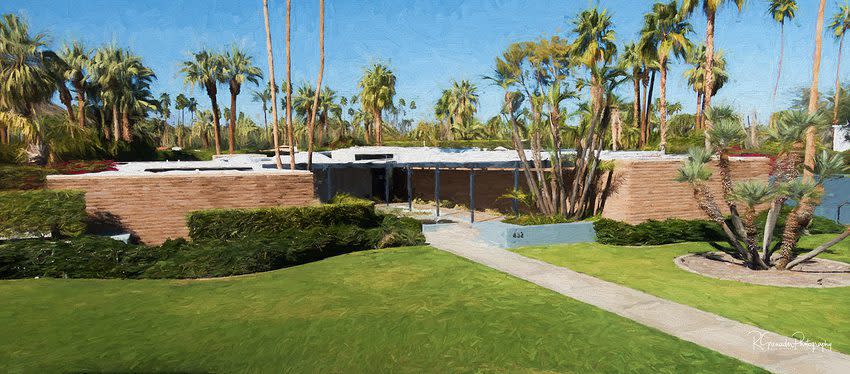
Turn right on N. Mission Road, turn left on W. Merito Place, right on N. Cahuilla, left on W. Alejo, right on N. Belardo, and then right on N. Museum Way. There is a municipal parking structure on your left.
Downtown Palm Springs
Palm Springs Art Museum (E. Stewart Williams 1976) – 101 N Museum Dr.
Williams designed the museum with concrete mixed with Warmtone cement and several aggregates. Long expanses of concrete panels were hammered to expose the aggregate. The exterior walls of the museum are clad in lava rock.
By the early 1980s, more space was needed to display the museum’s collection, so administrative functions were relocated to a new, separate structure just north of the original building. Named the Marks Administration Building, it was designed by Williams and completed in 1981.
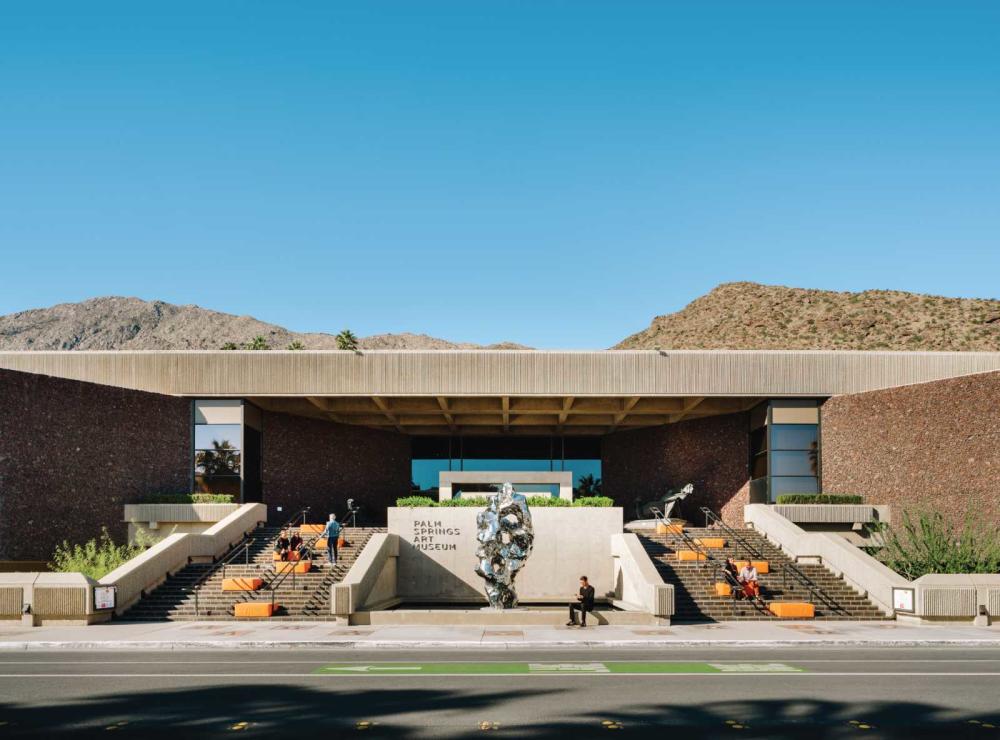
From the front of the Art Museum, head south on N. Museum Drive, turn left on W. Tahquitz Canyon Way, then right on S. Palm Canyon Drive.
Oasis Commercial Building (E Stewart Williams – 1953) – 121 S Palm Canyon Drive
This Class 1 historic site was designed in the International style by modernist architect E. Stewart Williams. It was built on a prominent corner that used to be a part of the Oasis Hotel. The two-story building reflects many of the design features of the internationally known Villa Savoy in Poissy, France, designed by Swiss architect Le Corbusier and built between 1928 and 1931, and the Brazilian Pavilion by Oscar Niemeyer from the 1939 New York World’s Fair.
Continue South on S. Palm Canyon to Baristo. The Architecture Museum is on your left.
Palm Springs Architecture and Design Center, Edward Harris Pavilion (E. Stewart Williams – 1961) – 300 S Palm Canyon Dr.
The museum’s architecture and design center is housed inside a classic midcentury International style building that Williams designed in 1961 for the Sante Fe Federal Savings & Loan.
The Santa Fe Federal Savings & Loan building reflected new thinking in the design of banks and financial institutions during the middle of the twentieth century. No longer were banks heavy masonry structures with neo-classical architecture – modern banks were seen as gathering places for the community, open and inviting. This building also featured a new concept: the drive-up banking window, which still exists on the east side of the building. The building is set up on a raised platform or “plinth” with recessed foundation walls, giving it the illusion that it is floating above the ground. Metal shade screens on sliding tracks were built into the west façade to help control direct son in the afternoon hours. The building’s main level features a gallery space for architecture and design exhibitions and curatorial offices. The lower level of the building serves as a study center and library.
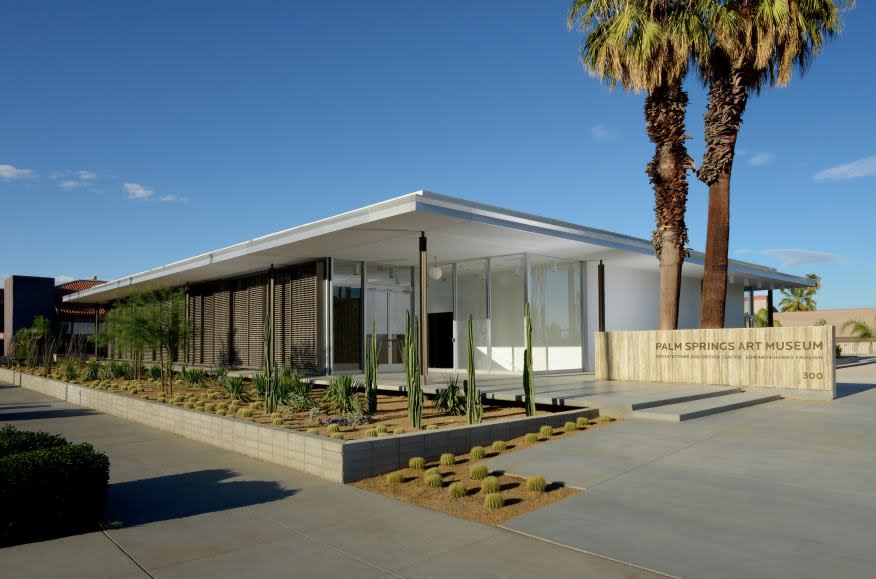
You can head toward the mountains on Baristo.
Del Marcos Hotel (William Cody – 1947) – 225 W Baristo Rd
In 1947, Cody completed the Del Marcos Hotel, his first independent commission, which the AIA Southern California Chapter recognized with an honorable mention. Cody had a prolific career in Palm Springs and the Coachella Valley and became known for his elegant, simplistic designs with ultra-thin columns and rooflines.
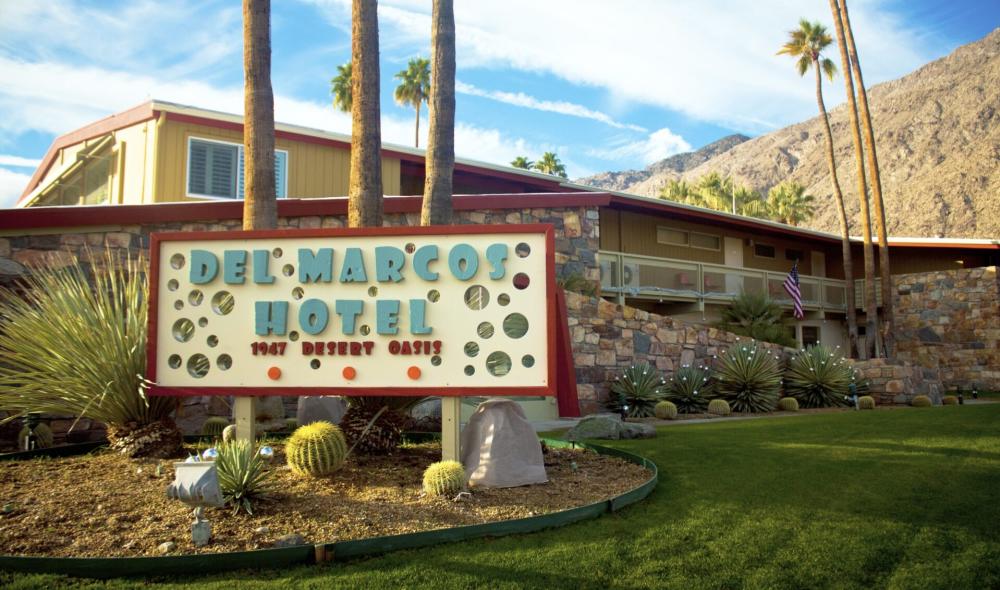
You can go back to S. Palm Canyon and turn right.
Coachella Valley Savings & Loan (now Chase Bank) – ( E. Stewart Williams – 1960) – 499 S Palm Canyon Drive
Originally the Coachella Valley Savings & Loan, the design of this elegant building with its inverted parabolic curved columns and water feature was inspired by the Palace of the Dawn by Brazilian Architect Oscar Niemeyer, completed in 1958 in Brasilia, Brazil.
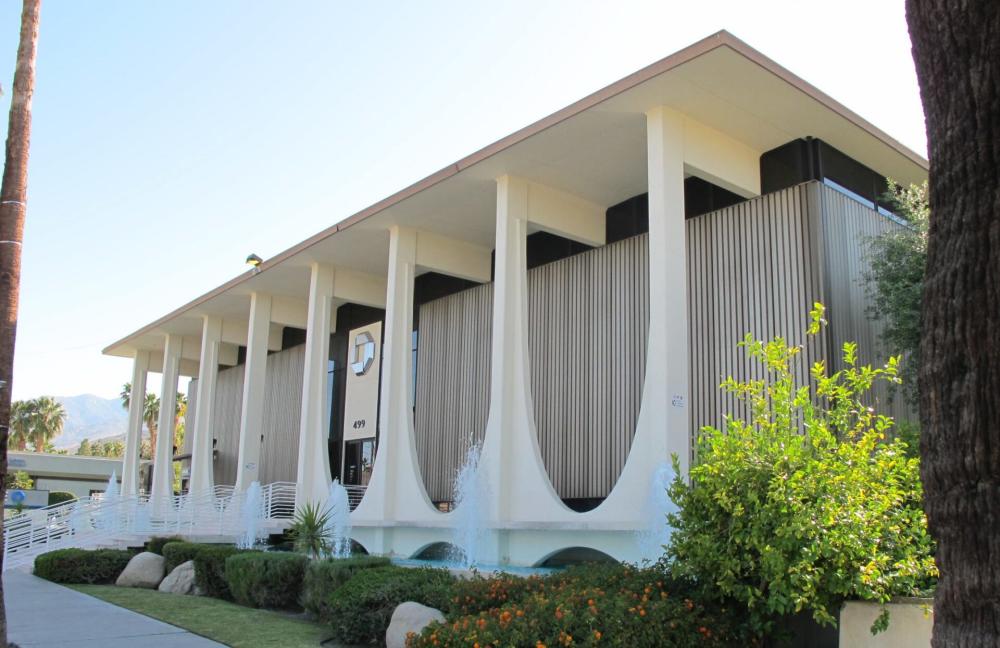
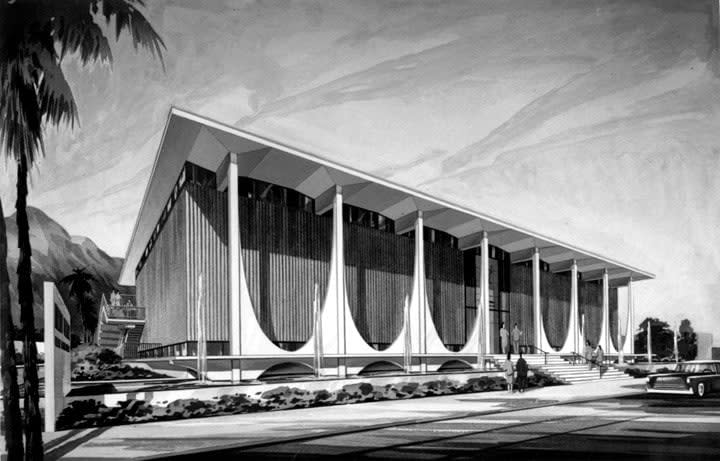
Musicland Hotel (Hugh Kaptur – 1967) – 1342 South Palm Canyon Drive
An earlier project similar in architectural style to Tahquitz Plaza (now Kaptur Plaza) is The Musicland Hotel, formerly the Casa Blanca Motor Hotel. Kaptur was commissioned to update and modernize the building and created the unique façade seen today with its sculptural “eyebrow” around the street-facing second-story window.
Continue south
The Mesa/Canyon Corridor/Twin Palms Estates
Royal Hawaiian Estates (Donald Wexler – 1961-1962) – 1774 South Palm Canyon Drive
Donald Wexler and Richard Harrison combined modernist ideas with Polynesian themes when they designed the Royal Hawaiian Estates condominium complex when tiki architecture was in fashion. The complex has 12 buildings with 40 condominium units on five acres.
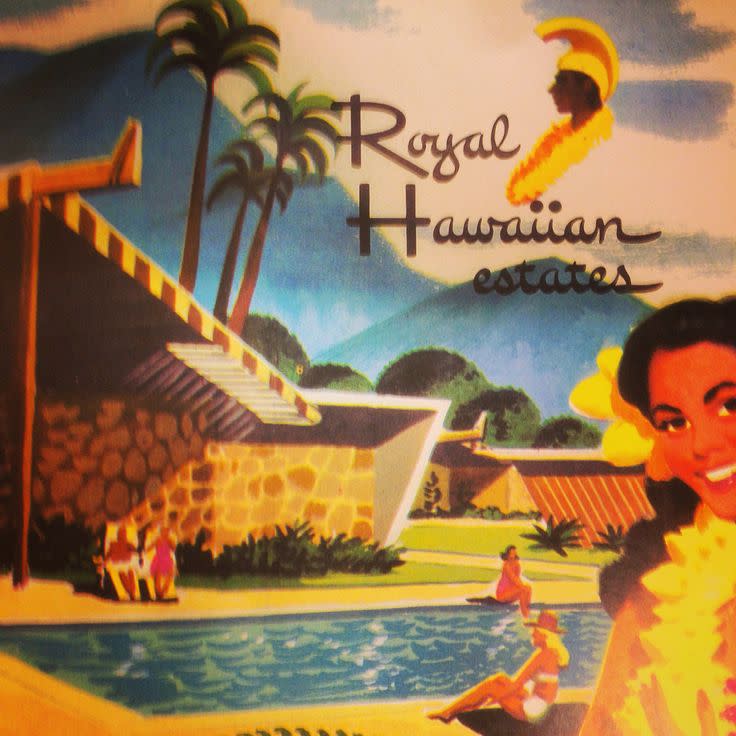
Drive south on South Palm Canyon and turn right on W Camino Carmelita. Turn left onto Camino Monte, and the property will be on your right.
Ship of the Desert – (Erle Webster & Adrian Wilson, Architects – 1936) – 1995 Camino Monte
The Davidson family had been visiting Palm Springs from the East Coast in the winter and decided to build a home in Mesa. They hired architectural firm Earle Webster & Adrian Wilson to design their winter home. Before 1936, architecture in the resort town was mainly Spanish Mission Revival. They decided to do something completely different and designed the house in the Streamline Moderne style. Reflecting imagery of automobiles, steamships, and airplanes, Streamline Moderne was a dominant style in the late 1920s and 1930s. “Ship of the Desert” was featured on the cover of Sunset Magazine in 1937.
In 1998, fashion designer Trina Turk and her photographer husband, Jonathan Skow, purchased the property with plans for an extensive restoration. However, during the house’s rehab, it was destroyed in a fire. Undeterred, they rebuilt using the original plans.
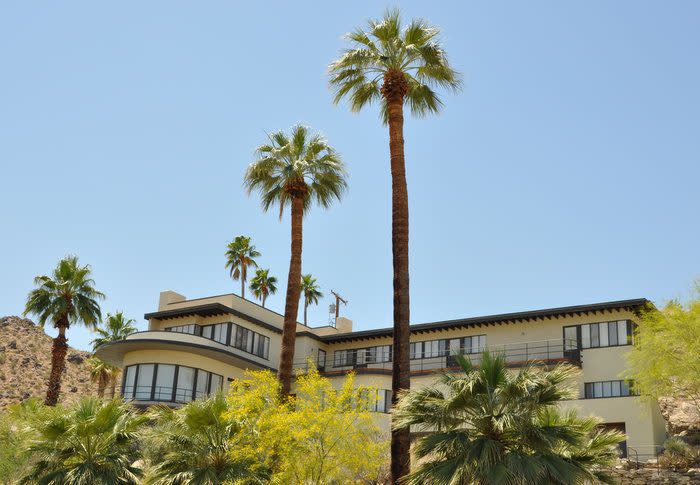
You can head back to South Palm Canyon Drive, turn right and then left onto La Verne Way.
Fire Station #4 (Hugh Kaptur – 1971) – 1300 S La Verne Way
The Palm Springs Fire Department was formed in 1931, several years before the small town was incorporated as a City in 1938. As Palm Springs grew, more fire stations were constructed, and until today, the City fire protection is provided by five fire stations. Fire Station #4 was built in 1971. Over time, the station began to show its age, and its facilities became outdated. Starting in the summer of 2017, work began on Fire Station #4 to remodel and expand it. The city consulted with Hugh Kaptur in the renovations so that the station could preserve his mid-century modern look and original vision. The City’s first fire station was located just north of the California Water & Telephone Building at 369 North Palm Canyon Drive (also a Class 1 historic site). Currently, the city’s oldest fire station is Fire Station #1, located at 277 North Indian Canyon. It was designed by architect Albert Frey in 1952 in the Modernist architectural style and is also a Class 1 historic site.
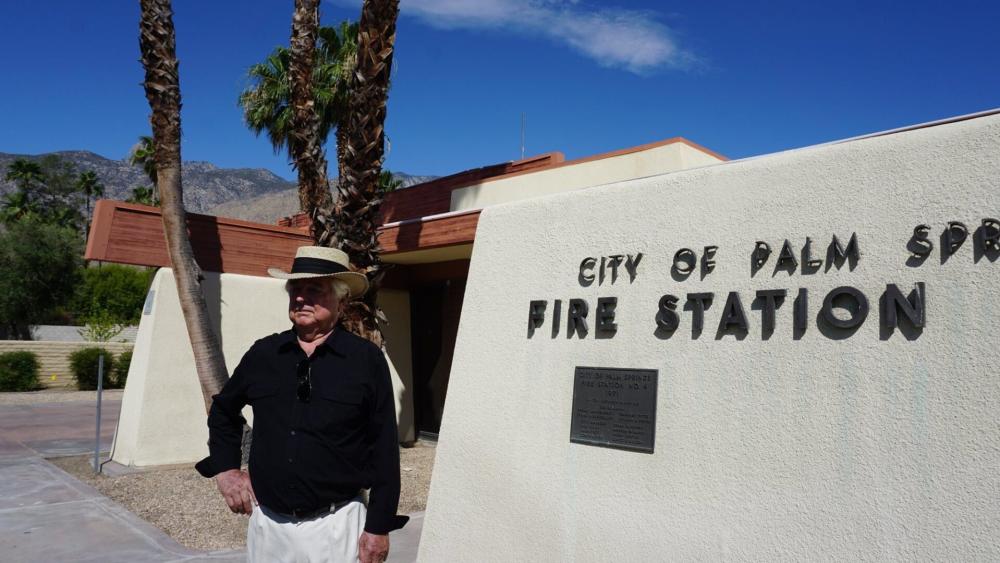
From here, head North on Sunrise Way to East Mesquite Ave. and turn left. Turn left again at South Driftwood Drive.
Deepwell Estates
William Holden Residence (1956) – 1323 S Driftwood Drive
The architect of this classic mid-century home has yet to be discovered. Located on an approximately 1-acre site in the heart of the prestigious Deepwell neighborhood, it is a unique example of a custom home using post and beam construction. Heavily renovated in 2017, the home, while dramatic in its all-white appearance, does not reflect the historic appearance of the house when actor William Holden owned it.
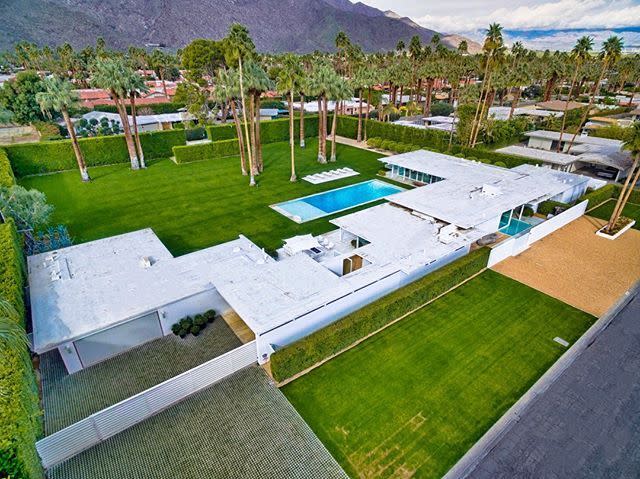
Head North on Driftwood and turn right on East Ocotillo Ave, then right again on South Calle De Maria.
Leo Koerner Residence (E. Stewart Williams – 1955) – 1275 Calle De Maria
A perfect example of Desert Modernism, the Koerner House was built for Leon and Thea Koerner, a pair of Canadian snowbirds.
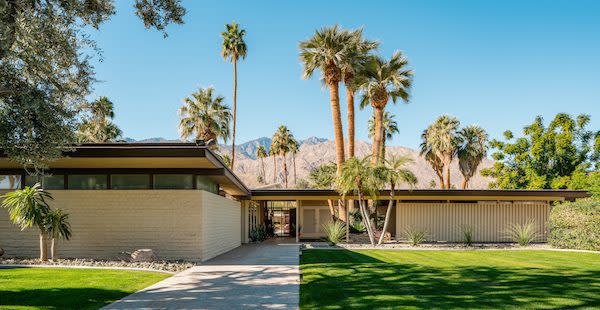
William Bogess Residence (Richard Harrison – 1955) – 1366 Calle De Maria
Featured in LA Times Home, January 1, 1956.
Head South on Calle De Maria, turn left Deep Well Rd, turn right onto Sagebrush Rd, turn left onto E Avenida Olancha, turn left at the 2nd cross street onto S Calle Marcus
John and Bessie Macy Residence (Hugh Kaptur – 1961) – 1577 Calle Marcus
Kaptur came to the desert in 1956, and Calle Marcus represents an early phase in Kaptur’s career during which he was experimenting with strong geometric forms, textures, and angles.
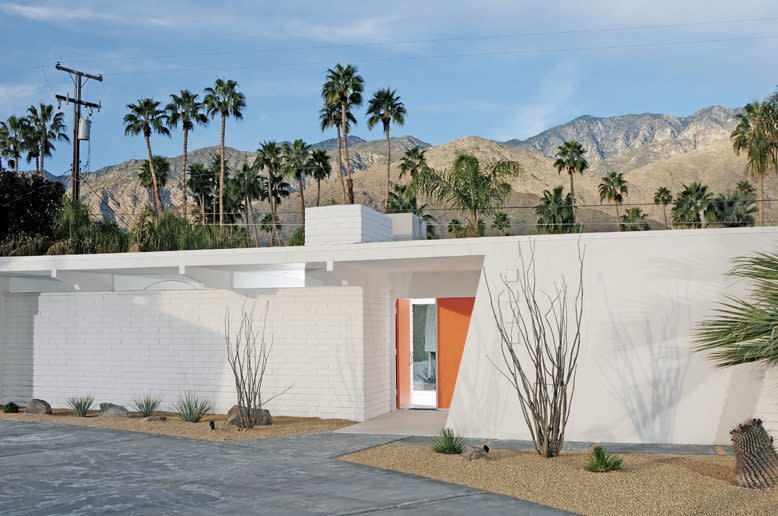
Sutter House (E. Stewart Williams – 1958) – 1207 Calle De Maria
Architecturally significant steel framed and concrete block structure wrapped in glass
Head back to Sunrise Way via Sout Mesquite Avenue and turn left. Go to Ramon Road and turn right. St. Theresa will be on your left.
St. Theresa Catholic Church (William Cody – 1968) – 2800 East Ramon Rd.
The 10-foot marble altars were carved in Italy to Cody’s precise specifications, where the sculptured ceilings drape like tented fabric, and the clerestory windows welcome broad rays of natural light. The main entrance is at the base of a cross shape. Outside, the red and yellow stained glass are in a pattern designed by Cody.
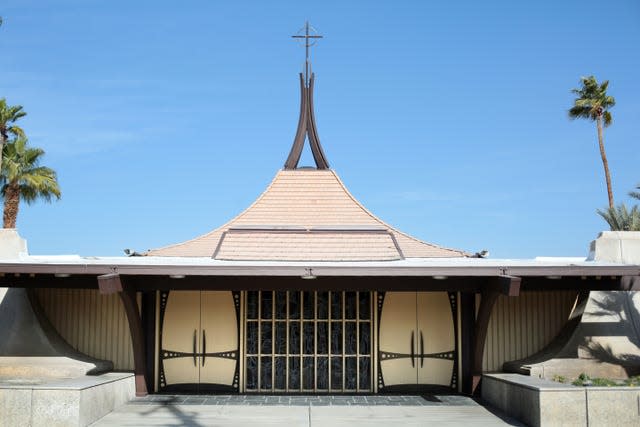
Heat West to Farrell Drive and make a right. Go .6 miles to Tahquitz Canyon Way and make another right. Go .5 miles, and City Hall is on your left.
Palm Springs City Hall – (Clark, Frey & Chambers with collaboration by Williams, Williams, and Williams – 1956)
3200 East Tahquitz Canyon Way
Clark & Frey began the preliminary Palm Springs City Hall design in 1952. The buildings’ volume and massing reflect the Modernist tenet “Form follows Function”, in which the various elements, such as the Council chamber, are distinctly different from the administrative office wings, reflecting the different functional uses of the spaces within. Like many of Frey’s designs, City Hall is constructed of simple, almost industrial materials such as unfinished concrete blocks, corrugated metal, and poured-in-place concrete. The design incorporates a circular motif – found in the round opening in the roof of the main entry, the angled metal cylinders comprising the bris soliel screen across the front of the executive offices, protecting the large areas of glass behind. A poured-in-place circular concrete roof element is located at the entry to the Council chamber, which is the same diameter as the opening in the many entries, creating a dynamic interplay between solid and void. Simple corrugated metal and fiberglass panels are used at entries, and corrugated metal screens over the western wing provide solar control for the offices in that wing. Several additions in 1965, 1972, and 1985 were added to the back (north) side of City Hall. These additions are not considered historically significant but did add much-needed office space as the City grew.
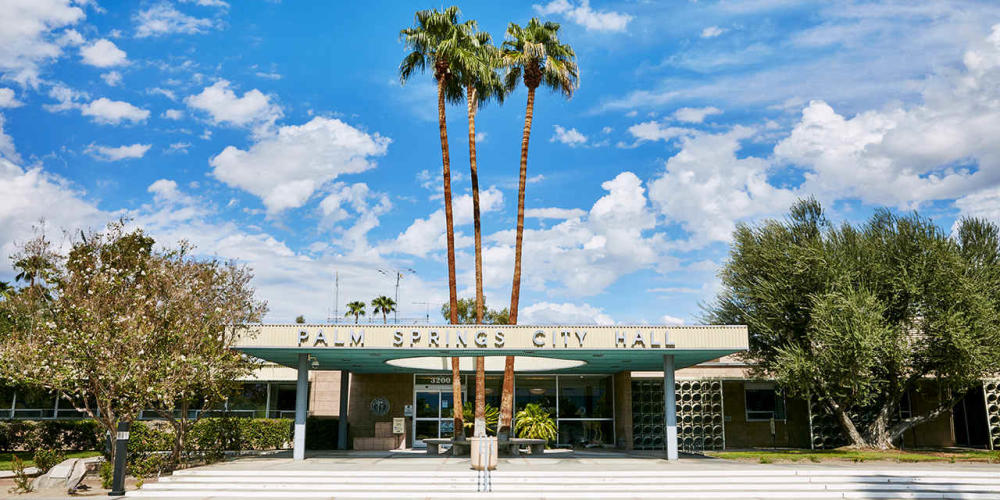
Sunmor Estates/Enchanted Homes
Donald Wexler & Ric Harrison – 2928, 2968, and 2980 Plaimor Drive, 260 N Airlane Dr
Wexler and Harrison worked for architect William Cody when they first came to Palm Springs in the early 1950’s. They formed the architectural firm of Wexler and Harrison in 1952 and collaborated on many projects until the firm was dissolved amicably in 1961.
Dan Palmer & William Krisel – 204, 205, and 206 North Airlane Drive
Head west to North Farrell Drive, turn right and then left on East Alejo Road. The Sinatra house will be on your right.
Movie Colony
Twin Palms – Sinatra Residence(E. Stewart Williams – 1947) – 1148 Alejo Road
Sinatra first came to Palm Springs in search of a weekend home for his family after signing a lucrative movie contract with MGM. Sinatra initially requested designs for a Georgian-style mansion, complete with a brick facade and columns. He had just made his first million and wanted to celebrate in grand style.
However, with renderings of a house composed of long horizontal tines and non-traditional building materials, Williams was able to lure Sinatra away from the idea of a Georgian house towards something more “desert appropriate.” Later, Roger Williams, Stewart’s architectural partner and brother, reflected, “We’d have been ruined if we’d been forced to build Georgian in the desert.”
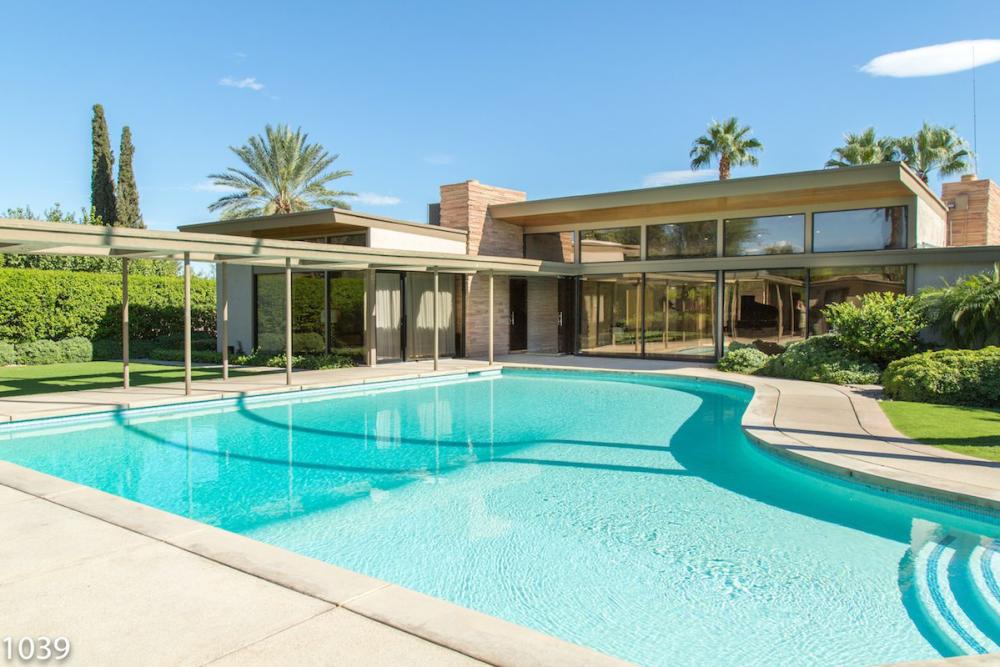
Other Noteworthy Properties
Frey House II – (Albert Frey, 1963, expanded 1967) 686 Palisades Drive
Albert Frey’s second home in Palm Springs is an essay in minimalist steel and glass integrated with the rocky mountainous site on which it is located. Frey left large natural rock outcroppings on the site and integrated them to subdivide the main living space from the adjacent bedroom. The house is owned by the Palm Springs Art Museum, which occasionally conducts limited site tours.
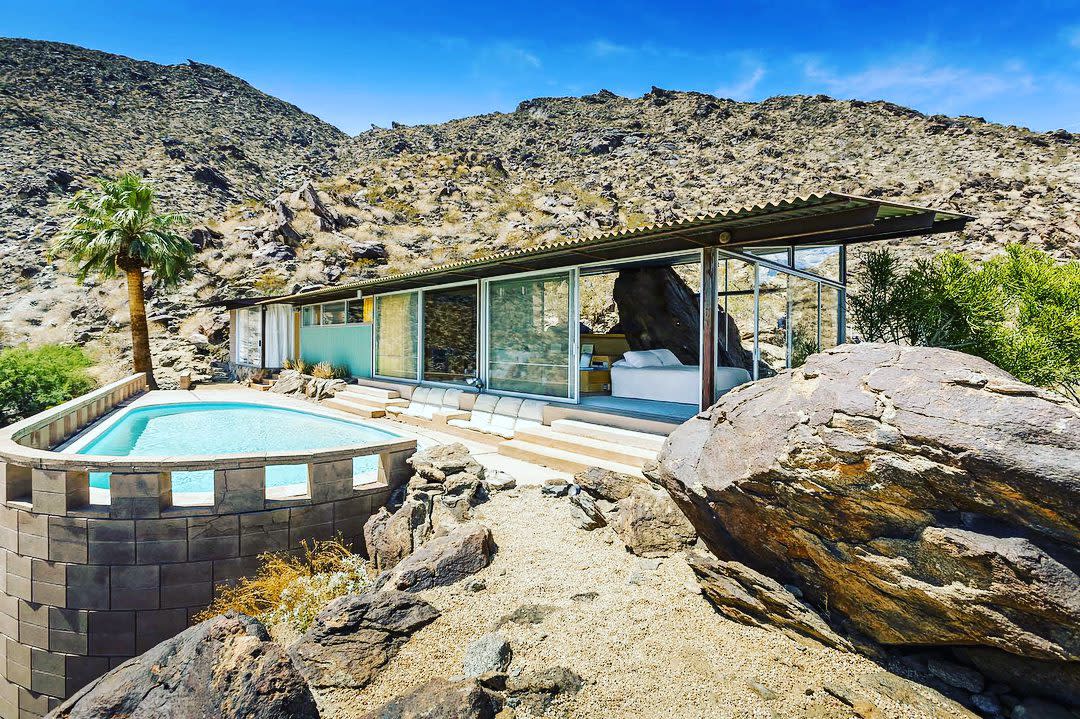
Other noteworthy mid-century modern sites that the Palm Springs City Council has granted Class 1 Landmark status include:
City National Bank (Now Bank of America) 588 South Palm Canyon Drive (inspired by the Chapel at Ronchamp France by Le Corbusier).
The Town & Country Center (Architects Paul R. Williams and A. Quincy Jones in collaboration with Donald Wexler, 1948 – 1955) is a fascinating amalgamation of buildings and styles. It reflects the emerging popularity after World War II for modernist architecture and a break with traditional, revivalist architectural styles of the 20s and 30s. 175 North Palm Canyon Drive.
Kocher-Samson Building (Architect Albert Frey 1936, one of the earliest Modernist structures built in Palm Springs. )
J.W. Robinsons’ Department Store (Architects Luckman and Pereira, 1958) is a classic mid-century department store with a “bow-tie” motif on the roof fascia, aggregate “zig-zag” masonry veneer walls, and unique tapered and ribbed steel columns.
By Randy Garner and Ken Lyon
You May Also Like:
Palm Springs Stars’ Homes: Self-Guided Tour
As you wander through the streets of Palm Springs, you’ll find yourself immersed in the allure of the…
